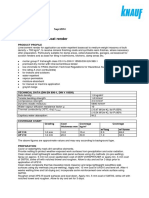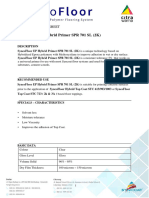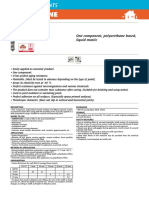PDS-PITTSEAL 444n-En
PDS-PITTSEAL 444n-En
Uploaded by
이선엽Copyright:
Available Formats
PDS-PITTSEAL 444n-En
PDS-PITTSEAL 444n-En
Uploaded by
이선엽Original Title
Copyright
Available Formats
Share this document
Did you find this document useful?
Is this content inappropriate?
Copyright:
Available Formats
PDS-PITTSEAL 444n-En
PDS-PITTSEAL 444n-En
Uploaded by
이선엽Copyright:
Available Formats
Product data sheet
PITTSEAL® 444N
Sealer
Page: 1 Date: 05.08.2015 Replaced: 31.03.2015 www.foamglas.com
1. Description and area of application
®
PITTSEAL 444N is a single component, non-hardening butyl
based sealer which does not dry but forms a soft skin after 1
®
to 3 hours. PITTSEAL 444N sealant can be used:
For Industry applications:
®
- to seal joints between FOAMGLAS slabs or pipe coverings
- to seal protrusions and metal jacket laps
- to seal wall/ceiling, wall/floor and wall/wall junctions
- as a sliding layer in expansion/contraction joints
®
- as bedding compound behind FOAMGLAS insulation on
piping and machinery.
® ®
PITTSEAL 444N adhere to FOAMGLAS cellular glass and
many other surfaces such as steel, concrete, wood etc.
For Building applications:
®
Sealing joints between FOAMGLAS slabs and boards.
Sealing of wall/ ceiling wall / floor and wall / wall junctions.
2. Application
2.1 Preparation of the substrate
The surface to be insulated should be clean, dry and free from all traces of grease, rust, dust, oil, and moisture.
2.2 Preparation of the sealant and application guideline
® ®
PITTSEAL 444N works easily within the suggested application temperature range. To apply the PITTSEAL 444N at
low temperature, keep the drums in a heated location, alternatively loosen lid and warm by indirect heat. Do not
heat drums with flame or direct heat. DO NOT DILUTE with solvent.
- Joints should be leveled before application of sealant.
- Best applied by extrusion gun or from cartridges. Trowel or knife can be used for restricted areas.
®
- PITTSEAL 444N may be applied to one or both surfaces. Press firmly in order to obtain a complete seal.
- Maintain a 3mm maximum thickness for the joints. Do not use this to fill large voids from or gaps due to poor fitting.
- To seal expansion joints, apply the sealant on both joining surfaces, and if necessary pack tightly. The joint width is
determined by the expected movement, and should not exceed 15mm.
- Cut off any excess sealant flush with surface.
- Allow to cure one week before putting the installation in service, specially at high temperature service.
2.3 Cleaning the tools
With white spirit or chlorinated solvents.
2.4 Limitations
May pick up dust when exposed. Solvent may attack some organic foams.
2.4 Product Safety Notice
All material safety data sheets (MSDS) are available. They aim to ensure a safe handling of the product and correct
disposal.
- Combustible mixture containing mineral spirits: store out of direct sunlight and keep away from open flames.
- Avoid prolonged contact with skin.
- Use in sufficiently aerated areas.
- Close the drums after use.
Product data sheet
PITTSEAL® 444N
Sealer
Page: 2 Date: 05.08.2015 Replaced: 31.03.2015 www.foamglas.com
3. Type of delivery and storage
Drums of 20 l (30 kg) net or cartridges of 0.310 l.
- Store cool and dry in well-closed containers.
- Protect against heat and direct exposure to sunrays.
- Protect against frost.
4. Consumption
As surface coating: approx. 5.2 kg/m² (thickness of final layer 3mm)
As jointing sealing: 0.25 kg/m (for 3mm opening joint x 50mm)
®
These quantities are for guidance only; they depend on the properties of the substrate, the thickness of the FOAMGLAS
slabs, the application and site conditions, etc.
5. Key data
Type One-component adhesive
Basis Butyl based sealant
Consistency pasty
Service temperature - 50 °C to + 80 °C
Application temperature (air + basis surface) + 10 °C to + 25 °C
Application time at 20 °C: approx. 90 minutes
Drying time non-drying, skin in 1-3 hours
Dehydration time –
Mass density approx. 1.5 kg/dm3
Colour grey
Water vapour diffusion resistance μ = approx. 23 000
Water solubility insoluble after complete drying
Solvents mineral oil solvents
Reaction to fire (EN 13501-1) –
VOC 102 g/l
Giscode –
Permeability 0.01 perm cm
Flash point (Pensky Martens Closed Cup) +40 °C
Solids 84 % of volume
The physical properties indicated above are average values, which are measured under typical conditions. These values
may be influenced by insufficient mixing, the type of laying, the layer thickness and the atmospheric conditions during and
after application In particular drying times are affected by temperature, air humidity, direct sunlight, wind, etc.
Additional information can be found in our technical data sheets (TDS). Our liability and responsibility are guided exclusively by our general terms and
conditions and are not expanded by the statement of our technical documents nor by the advice of our technical field service.
You might also like
- Solubility Curve WorksheetDocument3 pagesSolubility Curve Worksheetapi-29824787350% (2)
- 3 1 Thermodynamics of CorrosionDocument38 pages3 1 Thermodynamics of Corrosion이선엽100% (2)
- Solubility Behavior of Organic CompoundsDocument7 pagesSolubility Behavior of Organic CompoundsWinston Jake Gerolaga100% (2)
- Pittseal 444N Sealer: 1. Description and Area of ApplicationDocument2 pagesPittseal 444N Sealer: 1. Description and Area of ApplicationElie AouadNo ratings yet
- PDS-PC 85-EnDocument2 pagesPDS-PC 85-EnQuang Trung NgoNo ratings yet
- Ikote Pu X40 TDSDocument2 pagesIkote Pu X40 TDScarlosmendozaiiiNo ratings yet
- TDS - Durathane English Issued.09.05.2011Document4 pagesTDS - Durathane English Issued.09.05.2011vitharvanNo ratings yet
- TDS Pattex BondsealfillDocument5 pagesTDS Pattex BondsealfilldknisNo ratings yet
- TDS - Penguard Midcoat - Issu.26.11.2010 PDFDocument4 pagesTDS - Penguard Midcoat - Issu.26.11.2010 PDFvitharvanNo ratings yet
- Pilot II (ENG)Document4 pagesPilot II (ENG)Evan BadakNo ratings yet
- Jotashield Primer: Technical Data SheetDocument3 pagesJotashield Primer: Technical Data Sheetmm ssNo ratings yet
- Don't Just Buy Another Product Buy A SOLUTION: Characteristics: CH TitiDocument2 pagesDon't Just Buy Another Product Buy A SOLUTION: Characteristics: CH TitiLion YangNo ratings yet
- TDS SAFEGUARD EnglishDocument4 pagesTDS SAFEGUARD EnglishthirdNo ratings yet
- Polycoat Rbe FR: Rubberized Bitumen EmulsionDocument2 pagesPolycoat Rbe FR: Rubberized Bitumen EmulsionAbidNo ratings yet
- UP210 Lime/cement Basecoat Render: Data Sheet Sept 2014Document3 pagesUP210 Lime/cement Basecoat Render: Data Sheet Sept 2014Francesco FanaraNo ratings yet
- Fevicol PurDocument3 pagesFevicol PurVenkata ChadaNo ratings yet
- Udzbenik Fizika MR - SC - Josip Paic V.predDocument2 pagesUdzbenik Fizika MR - SC - Josip Paic V.predsoldier855No ratings yet
- TDS MARATHON EnglishDocument4 pagesTDS MARATHON EnglishthirdNo ratings yet
- PDS Terostat PCFRi enDocument2 pagesPDS Terostat PCFRi enDherbecourtNo ratings yet
- Jotaguard 630Document4 pagesJotaguard 630Christine HermawanNo ratings yet
- TDS Tankguard 412 English (Uk) Issued.22.05.2009Document4 pagesTDS Tankguard 412 English (Uk) Issued.22.05.2009Ahmed NabilNo ratings yet
- PDS7010EDocument2 pagesPDS7010EElie KhawandNo ratings yet
- PDS-PC 80m-EnDocument2 pagesPDS-PC 80m-EnJaiNo ratings yet
- PDS PC56 enDocument2 pagesPDS PC56 ennusretaNo ratings yet
- Estoseal c500PF - Cold Applied SealantDocument2 pagesEstoseal c500PF - Cold Applied SealantjoshepNo ratings yet
- Firemask-Sq-2600 TDSDocument2 pagesFiremask-Sq-2600 TDSiaabaoNo ratings yet
- Jotacote UniversalDocument4 pagesJotacote UniversalRidwan BaharumNo ratings yet
- Penguard Midcoat: Technical DataDocument3 pagesPenguard Midcoat: Technical DataMohamed FarhanNo ratings yet
- TDS Pattex PL200 2Document2 pagesTDS Pattex PL200 2ahmadbardawilkamalNo ratings yet
- Soudafoam 1KDocument2 pagesSoudafoam 1KCHERIF YAHIANo ratings yet
- SyncoFloor - EP Hybrid Primer SPR 701 SL (2K)Document5 pagesSyncoFloor - EP Hybrid Primer SPR 701 SL (2K)Sam Z PahNo ratings yet
- 1 Component KiiltoDocument2 pages1 Component KiiltoMantas ButrimaviciusNo ratings yet
- Hardtop Flexi: Technical DataDocument3 pagesHardtop Flexi: Technical DataMohamed FarhanNo ratings yet
- Penguard Primer: Technical DataDocument3 pagesPenguard Primer: Technical DataMohamed FarhanNo ratings yet
- Fenomastic EnamelDocument9 pagesFenomastic EnamelhemajsuryaNo ratings yet
- TDS - Penguard Topcoat - English (Uk) - Issued.26.11.2010 PDFDocument4 pagesTDS - Penguard Topcoat - English (Uk) - Issued.26.11.2010 PDFNPTNo ratings yet
- Penguard Midcoat MIODocument3 pagesPenguard Midcoat MIOMohamed FarhanNo ratings yet
- Watertite TSDocument2 pagesWatertite TSAlexi ALfred H. TagoNo ratings yet
- Gardex Premium Gloss: Technical Data SheetDocument3 pagesGardex Premium Gloss: Technical Data SheetBhayu Senoaji Dwi PrimasanjoyoNo ratings yet
- Jotatemp 650 (ENG)Document3 pagesJotatemp 650 (ENG)Dedi KartiwaNo ratings yet
- TDS - Pilot II - English (Uk) - Issued.12.03.2012 PDFDocument4 pagesTDS - Pilot II - English (Uk) - Issued.12.03.2012 PDFNPTNo ratings yet
- TDS - ROOFGUARD - English - Issued.18.11.2002 PDFDocument3 pagesTDS - ROOFGUARD - English - Issued.18.11.2002 PDFBNo ratings yet
- Jazeera Epo-Mortar SL5000Document3 pagesJazeera Epo-Mortar SL5000Ahmad BougeisNo ratings yet
- THMT SCDocument2 pagesTHMT SCZaheer Ahmad RazaNo ratings yet
- Jotashield Extreme: Technical Data SheetDocument3 pagesJotashield Extreme: Technical Data SheetAchraf BoudayaNo ratings yet
- 656d600221de5 w030 DR Fixit Triflex Protect PDFDocument3 pages656d600221de5 w030 DR Fixit Triflex Protect PDFfaizansari212No ratings yet
- Condensation in Metal BuildingDocument7 pagesCondensation in Metal BuildingMegha JJNo ratings yet
- Transunilac Finish 331Document4 pagesTransunilac Finish 331bhukyanaik02No ratings yet
- Fisa Tehnica Sistem - SikafloorMultiFlexPB-51 - Car Park Decks - Certificare OS 11bDocument4 pagesFisa Tehnica Sistem - SikafloorMultiFlexPB-51 - Car Park Decks - Certificare OS 11bGeorge EnescuNo ratings yet
- DatasheetDocument3 pagesDatasheetAbu Hanif Al KabumainyNo ratings yet
- Ottocoll® A 265 Topfix: Technical DatasheetDocument3 pagesOttocoll® A 265 Topfix: Technical DatasheetGalih MedanNo ratings yet
- TDS - Penguard Primer - Issued.26.11.2010Document4 pagesTDS - Penguard Primer - Issued.26.11.2010vitharvanNo ratings yet
- Cermithane Tds en 2Document2 pagesCermithane Tds en 2Hawraz MuhammedNo ratings yet
- TDS 418 GlueDocument3 pagesTDS 418 GlueKhaled OmairiNo ratings yet
- Sikaflex 11FC Technical Data SheetDocument5 pagesSikaflex 11FC Technical Data SheetIlies CristinaNo ratings yet
- TDS - Muki Z 2008 - English (Uk) - Issued.26.11.2010Document4 pagesTDS - Muki Z 2008 - English (Uk) - Issued.26.11.2010Keith ChooNo ratings yet
- Pittclad 316S PDS 7.13.21Document4 pagesPittclad 316S PDS 7.13.21MassimoPartipiloNo ratings yet
- Flexoplast®: Product Data SheetDocument2 pagesFlexoplast®: Product Data SheetRoyete M Silfani PattyNo ratings yet
- JotasealerDocument3 pagesJotasealerphan tuan datNo ratings yet
- Elastosil E43 N Transparent: Moisture Curing Silicone Rubber (RTV-1)Document5 pagesElastosil E43 N Transparent: Moisture Curing Silicone Rubber (RTV-1)Slim WennekerNo ratings yet
- iKOTE AC 40 (DEC-2023) V1.3Document2 pagesiKOTE AC 40 (DEC-2023) V1.3nguyen hoang AnhNo ratings yet
- Polycoat RTLDocument2 pagesPolycoat RTLniaz05288No ratings yet
- Edarabia Raha International School Abu Dhabi Adek Rating 2018Document19 pagesEdarabia Raha International School Abu Dhabi Adek Rating 2018이선엽No ratings yet
- 2024 Ulaanbaatar Awards For PostingDocument443 pages2024 Ulaanbaatar Awards For Posting이선엽No ratings yet
- Sakephen - Si 14 EG REDocument1 pageSakephen - Si 14 EG RE이선엽No ratings yet
- High Temperature Coking Resistance of An Alumina Forming AlloyDocument12 pagesHigh Temperature Coking Resistance of An Alumina Forming Alloy이선엽No ratings yet
- Practical Aspects Corr Protect EngDocument217 pagesPractical Aspects Corr Protect Eng이선엽No ratings yet
- 08a Mitigation of Corrosion by Cathodic ProtectionDocument25 pages08a Mitigation of Corrosion by Cathodic Protection이선엽No ratings yet
- Solar Roll PE55Document2 pagesSolar Roll PE55이선엽No ratings yet
- Foster PDS 60 90 60 91 R1119Document2 pagesFoster PDS 60 90 60 91 R1119이선엽No ratings yet
- KNPC Project Spec - CP Design BasisDocument40 pagesKNPC Project Spec - CP Design Basis이선엽No ratings yet
- Offshore Structural MaterialsDocument6 pagesOffshore Structural Materials이선엽No ratings yet
- MP Delta T Marine Non-Milspec 15OCT2008Document6 pagesMP Delta T Marine Non-Milspec 15OCT2008이선엽No ratings yet
- CH.6. G G C C: Alvanic Alvanic Orrosion OrrosionDocument20 pagesCH.6. G G C C: Alvanic Alvanic Orrosion Orrosion이선엽0% (1)
- Carbotherm 3300 PDSDocument4 pagesCarbotherm 3300 PDS이선엽No ratings yet
- Ninja Ramen Menu 2022Document2 pagesNinja Ramen Menu 2022이선엽No ratings yet
- PDS - FOAMGLAS ONE-ASTM-enDocument2 pagesPDS - FOAMGLAS ONE-ASTM-en이선엽No ratings yet
- AC Interference AssessmentDocument17 pagesAC Interference Assessment이선엽No ratings yet
- Introduction To CorrosionDocument8 pagesIntroduction To Corrosion이선엽No ratings yet
- CH.4. PP: Assivity AssivityDocument38 pagesCH.4. PP: Assivity Assivity이선엽100% (1)
- 4-Electrochemical Kinetics of CorrosionDocument84 pages4-Electrochemical Kinetics of Corrosion이선엽No ratings yet
- 8-Pitting and Crevice CorrosionDocument19 pages8-Pitting and Crevice Corrosion이선엽No ratings yet
- 2-Corrosion Rate MeasurementDocument32 pages2-Corrosion Rate Measurement이선엽100% (1)
- 01-Basics of CorrosionDocument31 pages01-Basics of Corrosion이선엽No ratings yet
- 3 2 Pourbaix DiagramDocument31 pages3 2 Pourbaix Diagram이선엽67% (3)
- 1-Forms of CorrosionDocument59 pages1-Forms of Corrosion이선엽100% (1)
- Microbiologically Influenced Corrosion of Polyethylene Coated Pipelines Buried in The Anaerobic SoilsDocument25 pagesMicrobiologically Influenced Corrosion of Polyethylene Coated Pipelines Buried in The Anaerobic Soils이선엽No ratings yet
- Week 5 - Solid-Liquid Extraction (Leaching) - UpdatedDocument49 pagesWeek 5 - Solid-Liquid Extraction (Leaching) - UpdatedPrecious AnaNo ratings yet
- Full Exp 4Document8 pagesFull Exp 4Rashdan CskNo ratings yet
- Gas Fluxing of Molten Aluminum: An Overview and Update: LiquidDocument8 pagesGas Fluxing of Molten Aluminum: An Overview and Update: LiquidMarcin LosyNo ratings yet
- Malayan Colleges Laguna Mapua Institute of Technology at LagunaDocument18 pagesMalayan Colleges Laguna Mapua Institute of Technology at LagunaAlyssa ApolinarioNo ratings yet
- Absorbsi - Part 1Document39 pagesAbsorbsi - Part 1Dyan DargustinNo ratings yet
- Phychem Lab Final SolubilityDocument9 pagesPhychem Lab Final SolubilityHirizza Junko YamamotoNo ratings yet
- Pharmacognosy Practical PDFDocument20 pagesPharmacognosy Practical PDFvaibhav namdevNo ratings yet
- Green Extraction, Synthesis, Characterization and Antifungal Screening of Copper (II) and Iron (III) Complexes of Used Herbal Tea (Chamomile)Document7 pagesGreen Extraction, Synthesis, Characterization and Antifungal Screening of Copper (II) and Iron (III) Complexes of Used Herbal Tea (Chamomile)International Journal of Innovative Science and Research TechnologyNo ratings yet
- 171 02 Sample LabDocument6 pages171 02 Sample Labmo7learnNo ratings yet
- XRD and Tga Investigation of Hardened Cement Paste DegradationDocument7 pagesXRD and Tga Investigation of Hardened Cement Paste DegradationKemal CellatNo ratings yet
- Potassium Chloride (Powder) : Product Data Sheet (PDS)Document1 pagePotassium Chloride (Powder) : Product Data Sheet (PDS)Iqbal batchaNo ratings yet
- BAB 9 Rajiv DuttaDocument86 pagesBAB 9 Rajiv DuttaYuhin meidina ocsaNo ratings yet
- Chemex DegreaserDocument6 pagesChemex DegreasersidsailNo ratings yet
- Surge-Somya Kumar SinghDocument6 pagesSurge-Somya Kumar SinghSomya kumar SinghNo ratings yet
- Contents of Volume 194 197 - 2002 - Fluid Phase EquilibriaDocument5 pagesContents of Volume 194 197 - 2002 - Fluid Phase EquilibriaAnonymous ypVNIINo ratings yet
- Solids Savvy: Solidify YourDocument17 pagesSolids Savvy: Solidify YoursvkatkarNo ratings yet
- Rice FtirDocument15 pagesRice FtirRavindra AgarwalNo ratings yet
- Sodium Bicarbonate - BP2022Document3 pagesSodium Bicarbonate - BP2022angela.evansNo ratings yet
- Planta de AcetilenoDocument50 pagesPlanta de AcetilenoEduardo Vazquez NavarreteNo ratings yet
- Pelatihan Bekerja Di KetinggianDocument3 pagesPelatihan Bekerja Di KetinggianDewie HardiningrumNo ratings yet
- Co2 Water Content ThermoDocument19 pagesCo2 Water Content ThermoAnushka GNo ratings yet
- Classified Chemistry Cambridge Igcse Paper 6 ScienceDocument358 pagesClassified Chemistry Cambridge Igcse Paper 6 ScienceMoumenNo ratings yet
- Pulsatile Drug Delivery Systems ..... FinalDocument58 pagesPulsatile Drug Delivery Systems ..... Finalparikhjigar100% (1)
- SODIUM ACETATE SpecificationDocument10 pagesSODIUM ACETATE Specificationbabji dudekulaNo ratings yet
- PROPERTIES OF WATER and CalculationsDocument7 pagesPROPERTIES OF WATER and CalculationsJairhiz AnnNo ratings yet
- Poly SugaMulse D9Document2 pagesPoly SugaMulse D9mndmattNo ratings yet
- Chemistry Notes CompleteDocument136 pagesChemistry Notes CompletePrayrit JainNo ratings yet
- Microscale Lipid IsolationDocument12 pagesMicroscale Lipid IsolationJustin_Tumanan100% (5)



















































































































